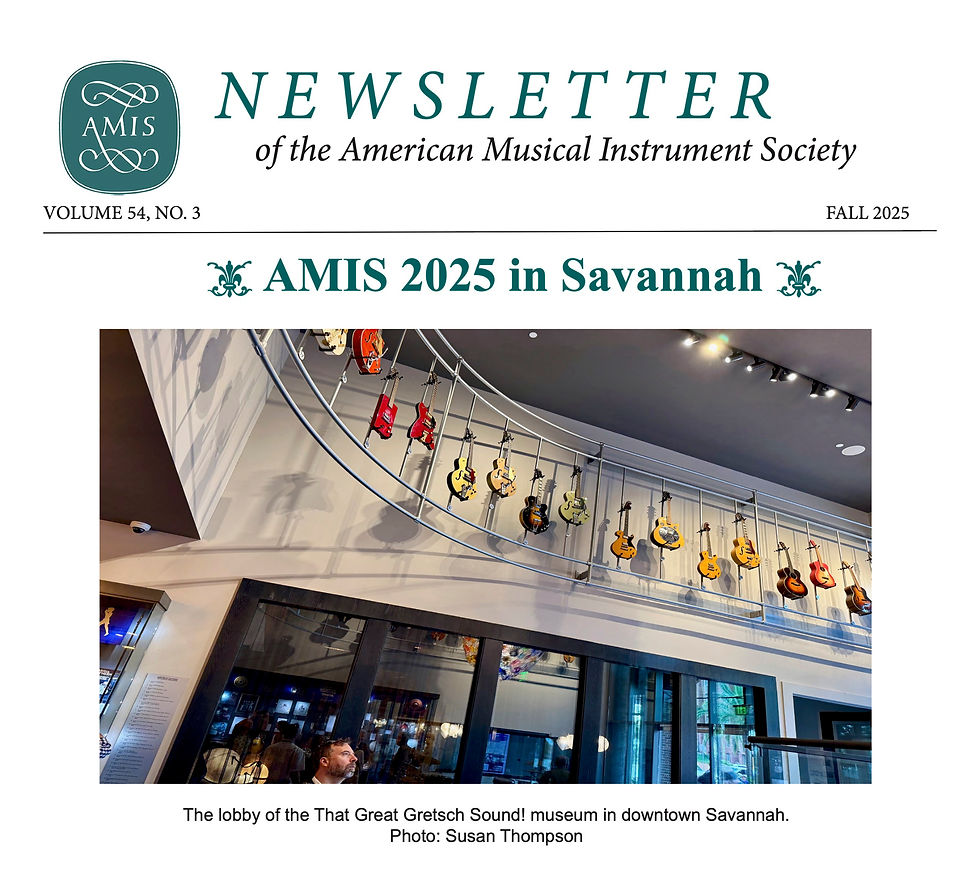Adjusting Museum Education for the Covid Era
- AMIS Blogs

- Nov 15, 2020
- 3 min read
***This is the second in a series that focus on the reopening of musical instrument collections in museums after the coronavirus shut down. Specifically, the series considers the new realities of social distancing and other safety precautions and their impact on collections.

Photo by PamMcP Own work, CC BY-SA 4.0
By Katherine Palmer
Like most institutions, the Musical Instrument Museum (Phoenix, Arizona) was forced to halt all in-person educational experiences in March 2020, and while the world faced an unprecedented global pandemic, educational institutions everywhere – museums included – were quickly forced to embrace the digital-learning environment. Over the course of MIM’s physical closure (March through July) and reopening (August 10), MIM’s education team has worked to pivot pre-existing programs into virtual offerings. We aimed to engage learners on different platforms and offer both synchronous and asynchronous options in order to meet the needs of educators, students, and families. Below is a summary of some these offerings:
1. In March and April, MIM Education re-created pre-existing educator resources into digital learning tool kits via Google Drive to give educators the ability to “assign” modules to students for asynchronous exploration. Learning kits are focused on K–8 Arizona State Standards and include topics about the Silk Road, cultural diffusion, geographic studies, and zoomorphic symbolism.
2. In mid-April, MIM took MIMkids Mini Music Makers (early childhood music and movement classes for children and caregivers) online via Zoom. Classes meet Wednesday mornings in two sessions: 10:15–10:45 for 0–3 year olds and 11:00–11:30 for 3–5 year olds. The online setting has been a wonderful way to stay engaged with the community and give caregivers options for things to do from home. Participants have included currently enrolled families, families that have relocated, and new families from outside the Phoenix area. July survey results were favorable, with one participant stating, “Thanks for creating this learning space during this time. We never thought of the MIM as a place to venture out to with our little one until now – we can’t wait to visit once things return to normal.”
3. In May, MIM began offering virtual Creative Aging: Memory Care and Music sessions for people with dementia living in assisted living facilities via Zoom. These 30-minute sessions include an introduction to MIM’s galleries with the curator of education and a music therapy portion with Dr. Melita Belgrave from Arizona State University. Sessions have continued twice a month and MIM has engaged 167 residents from 22 different facilities.
4. The most robust educational materials were developed between June–August and include two virtual field trips and one virtual artist residency concert. Virtual field trip packages include 50+ minutes of video content, tour stops around each of MIM’s Geographic Galleries, and standards-based activities in the form the videos and worksheets. The virtual artist residency performance takes students on a drum and dance tour of West Africa and the African diaspora with Kawambe-Omowale African Drum and Dance Theatre. This package also includes pre-, during, and post-viewing materials. To date, educators from 36 Arizona districts, 9 additional states, and 2 foreign countries have requested access. The numbers grow each week, but the previous numbers represent over 385 schools and 209,000 students.
In addition to these opportunities, we’re also building a remote professional development for PreK–12th grade educators titled “Object-Based Learning: Making Music Tangible.” Since traditional music making can be dangerous due to aerosols, object-based and project-based lessons are a great compromise for both music teachers and educators wanting to create an arts-integrated classroom. MIM Education has also contributed lessons and topics to FlipGrid and helped supplement MIM’s YouTube channel with video content.
While we do not know when we will be able to resume traditional, in-person educational classes and field trips, we have been able to share MIM with a whole new audience during this time. Additionally, these offerings have given MIM’s development team an opportunity to advocate for educational funding, which is an important part of all Covid-related arts discussions.

Katherine Palmer enjoys a multifaceted musical career and works as a performing musician, educator, and arts administrator. Katherine is the curator of education at the Musical Instrument Museum in Phoenix, where she is in charge of developing, teaching, and training others to deliver ethnomusicological education content. She is the Executive Director of Daraja Music Initiative (DMI), a non-profit organization that provides music and conservation education in Tanzania. Aiming to bridge the arts and sciences, DMI promotes sustainability of African Blackwood trees that instruments are constructed from. Katherine is passionate about arts-integration, world music pedagogy and object-based museum education.



Comments